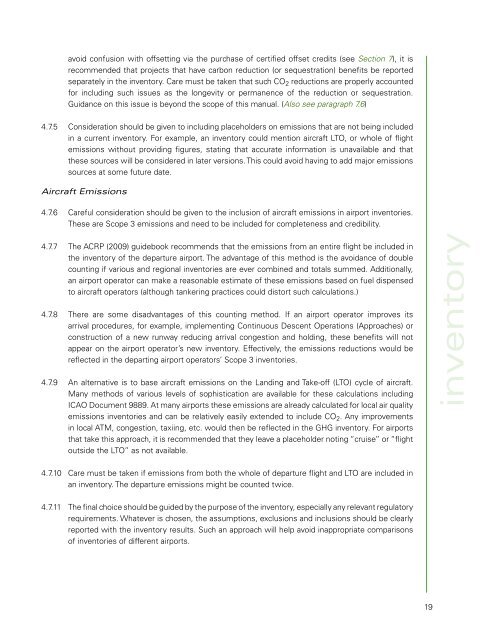Airport Greenhouse Gas Emissions Management - Zurich Airport
Airport Greenhouse Gas Emissions Management - Zurich Airport
Airport Greenhouse Gas Emissions Management - Zurich Airport
Create successful ePaper yourself
Turn your PDF publications into a flip-book with our unique Google optimized e-Paper software.
avoid confusion with offsetting via the purchase of certified offset credits (see Section 7), it is<br />
recommended that projects that have carbon reduction (or sequestration) benefits be reported<br />
separately in the inventory. Care must be taken that such CO 2 reductions are properly accounted<br />
for including such issues as the longevity or permanence of the reduction or sequestration.<br />
Guidance on this issue is beyond the scope of this manual. (Also see paragraph 7.6)<br />
4.7.5 Consideration should be given to including placeholders on emissions that are not being included<br />
in a current inventory. For example, an inventory could mention aircraft LTO, or whole of flight<br />
emissions without providing figures, stating that accurate information is unavailable and that<br />
these sources will be considered in later versions. This could avoid having to add major emissions<br />
sources at some future date.<br />
Aircraft <strong>Emissions</strong><br />
4.7.6 Careful consideration should be given to the inclusion of aircraft emissions in airport inventories.<br />
These are Scope 3 emissions and need to be included for completeness and credibility.<br />
4.7.7 The ACRP (2009) guidebook recommends that the emissions from an entire flight be included in<br />
the inventory of the departure airport. The advantage of this method is the avoidance of double<br />
counting if various and regional inventories are ever combined and totals summed. Additionally,<br />
an airport operator can make a reasonable estimate of these emissions based on fuel dispensed<br />
to aircraft operators (although tankering practices could distort such calculations.)<br />
4.7.8 There are some disadvantages of this counting method. If an airport operator improves its<br />
arrival procedures, for example, implementing Continuous Descent Operations (Approaches) or<br />
construction of a new runway reducing arrival congestion and holding, these benefits will not<br />
appear on the airport operator’s new inventory. Effectively, the emissions reductions would be<br />
reflected in the departing airport operators’ Scope 3 inventories.<br />
4.7.9 An alternative is to base aircraft emissions on the Landing and Take-off (LTO) cycle of aircraft.<br />
Many methods of various levels of sophistication are available for these calculations including<br />
ICAO Document 9889. At many airports these emissions are already calculated for local air quality<br />
emissions inventories and can be relatively easily extended to include CO 2 . Any improvements<br />
in local ATM, congestion, taxiing, etc. would then be reflected in the GHG inventory. For airports<br />
that take this approach, it is recommended that they leave a placeholder noting “cruise” or “flight<br />
outside the LTO” as not available.<br />
inventory<br />
4.7.10 Care must be taken if emissions from both the whole of departure flight and LTO are included in<br />
an inventory. The departure emissions might be counted twice.<br />
4.7.11 The final choice should be guided by the purpose of the inventory, especially any relevant regulatory<br />
requirements. Whatever is chosen, the assumptions, exclusions and inclusions should be clearly<br />
reported with the inventory results. Such an approach will help avoid inappropriate comparisons<br />
of inventories of different airports.<br />
19

















